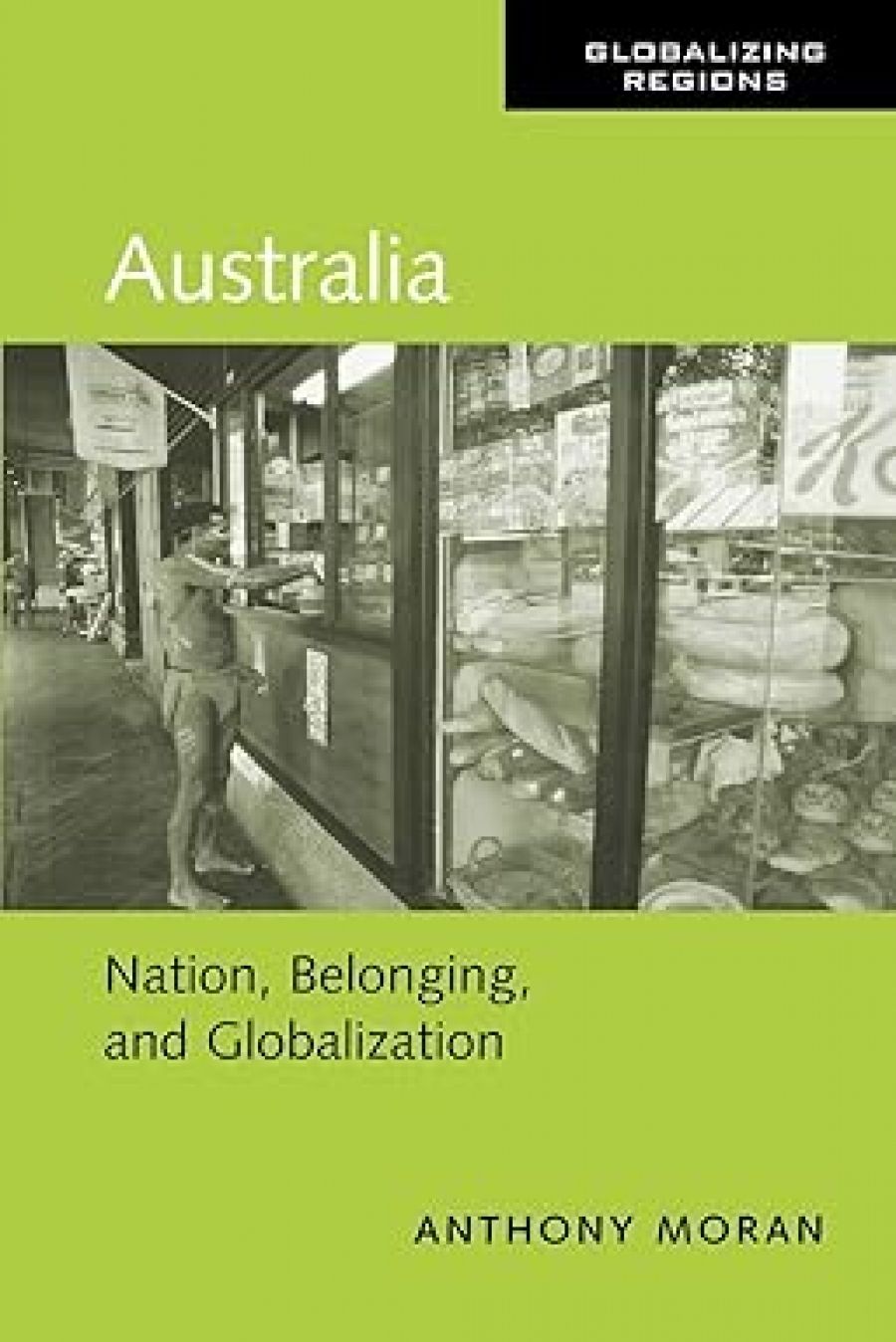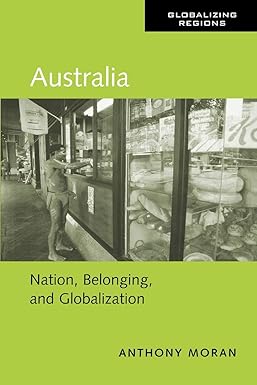
- Free Article: No
- Contents Category: Politics
- Review Article: Yes
- Article Title: Tensions and possibilities
- Online Only: No
- Custom Highlight Text:
Australians have been experiencing ‘intensified globalisation’ in the last twenty years. That is, our political leaders, ‘under the sway of neo-liberal ideology’, have made decisions that have ‘intensified’ the ‘widening, deepening and speeding up of worldwide inter- connectedness in all aspects of contemporary social life’ (David Held). They have curbed the influence of arbitration and promoted enterprise bargaining and individual contracts. They have deregulated banking and capital flows, and reduced tariff protection. They have made the tax system less progressive. They have reduced spending on social welfare. And they have privatised and corporatised many government services and utilities. Moran, preoccupied with political economy, tends to take as given the technological features of ‘intensified globalisation’ (the indexer saw no reason to include ‘computer’, ‘telephone’ or ‘Internet’). His sense of globalisation resembles Paul Kelly’s account of the dissolution of the Australian Settlement. With Australians becoming more ethnically diverse and less economically secure, there are ‘feelings of vulnerability and disorientation among the populace’.
- Book 1 Title: Australia
- Book 1 Subtitle: Nation, belonging, and globalisation
- Book 1 Biblio: Routledge, $39.95 pb, 245 pp, 041594497X
- Book 1 Cover Small (400 x 600):

- Book 1 Cover (800 x 1200):

Australia is a book of many voices. To understand how Australians live ‘globalisation’, Moran and his colleagues interviewed sixty men and women from 1986 to 1990 and from 2002 to 2004, harvesting 300 hours of talk. Quoting pseudonymously and extensively from twenty-four interviews, Moran has too much respect for social science to claim them as representative. They are ‘suggestive of broad patterns of experience’. The temptation to massage ‘suggestive’ into ‘representative’ is evident in his use of Don (‘a semi-retired Doctor’). Writing that Don is ‘representative of a certain generational experience’, he later says that Don’s is but ‘one important version of the modern national self’, and he never makes explicit the boundaries of ‘certain’.
As his chapter on indigenous Australians shows, Moran does not need to hear interviewees’ experiences – none of the twenty-four is indigenous, as far as I can tell – in order to have a confident grasp of what has been going on. If these interviews are ‘evidence’, then what they evince is nothing more than that Australians are diverse in their views about, and experiences of, how Australia has been changing since the 1980s. If the reader (like Moran) cannot draw conclusions beyond that indisputable observation, the interviews are nonetheless not superfluous. They function rhetorically to give Moran’s book an atmosphere of truthfulness, in much the same way that television vox pop, talk-back radio, newspaper letters pages and news vignettes of ‘ordinary’ people’s lives convey an impression of cultural institutions able and eager to speak from the position of their audience.
When some interviewees narrate experiences of moral and cultural discontinuity in their lives, Moran has two options: he can point to biographical facts (they are immigrants or they have moved through some life transitions or had business difficulties); or he can present their sense of discontinuity as reflecting changes in Australian society. It is both a strength and a weakness of this book that it attempts the recent history of a nation through the auto- biographies of individuals; generalisations about a changing national experience are persistently subverted by Moran’s attention to particular lives.
Nonetheless, because nations can be moral communities, writes Moran, it is important to look for commonalities of experience; he wants to know whether his informants imagine Australia as having some character and community of purpose. Do they perceive multiculturalism as a threat to moral community or as an evolved form of it? Have the pleasures of globalisation tugged some Australians into cosmopolitanism and/or individualism? For the most part, Moran is content to pose questions, but some conclusions emerge. One is that ‘multiculturalism is a reality’. The interviewees encourage Moran’s optimism about ‘multiculturalism’. The fears of its critics ‘are not necessarily reflective of experiences on the ground’. Citing Rosa (the daughter of Italian migrants), Katerina (a Greek-Australian teacher) and Pham (a Vietnamese refugee), he suggests that multiculturalism allows non-Anglo-Celtic Australians to identify with Australia. Citing Rob (a tradesman and union representative), Kel (a former shearer, now a small grazier) and Henry (a bank employee who is ‘willing to embrace anyone’, as Moran puts it), he finds subtlety and patience in Anglo-Celtic Australians’ accounts of their experience of ethnic diversity.
To warm to diversity has its traps, Moran concedes. He asserts that globalisation has eroded the wealthier professional class’s attachments to Australia and reduced their sense of obligation to other Australians. This has weakened ‘the financial basis of the welfare state in Australia’. Perhaps he is right, but it would be good to see some evidence beyond his recounting of Don’s impression that Australians in the 1980s lost their commitment to ‘egalitarianism and social justice’.
The moral community animated by multiculturalism imagines a boundary between itself and asylum seekers – ‘an amorphous threat’ to the sovereign habit of carefully choosing who can live in Australia. By invoking this sense of nationhood, governments, including the Howard government, legitimise (in a compensatory way) ‘intensified globalisation’ to people such as Mick (‘a late middle-aged Vietnam veteran’). Mick dismisses ‘do-gooders’, and conflates the ‘illegal immigrant’ and the Muslim. Wayne (an Australian-born mechanic), John and Eddie (both council workers) see Muslims as enemies of Australian freedoms. Vietnam veteran Bob cherishes Australia’s remoteness from a barbaric world. Because ‘a large part of politics involves the systematic organization of enmities, hatreds, and sympathies’, writes Moran, moral community may have ‘less than rational layers’ that are concealed by the interviewees’ calm talk of rules and sovereignty.
Indigenous Australians have adapted creatively to destructive waves of globalisation, he writes, and they are now part of a global reassertion of indigenous identities that ‘challenge’ some Australians’ ‘sense of national belonging’. After World War II, assimilation policy imagined indigenous Australians’ inclusion in the nation, but subsequent policies recognising their rights to land, family security and to a degree of self-government have perturbed this sense of nation. Nonetheless, some people now credit indigenous people with knowledge relevant to humans’ relationship with nature, and global trends in art and tourism create new economic niches in which they can be autochthonous persons. While their participation in global forums amplifies their domestic voice, they must still ‘engage with and cultivate the national community’ by arguing, for example, that in answering indigenous grievances Australia heals itself as a nation.
Do any of Moran’s interviewees sense the malaise that ‘healing’ implies? And what would indigenous interviewees – with their own reasons for xenophobia – say about ‘multiculturalism’ and asylum seekers? Without answers to these questions, Moran’s interviews do not ‘ground’ his consideration of whether there is the ‘emotional shift for settler Australians’ that he hopes will improve settler– indigenous relations.
A title in Routledge’s ‘Globalizing Regions’ series, Australia’s deft summaries and illustrative personae will vividly introduce overseas readers to the tensions and possibilities within contemporary Australian political culture. For readers more familiar with the country, Australia will be a reminder of what we know already.


Comments powered by CComment